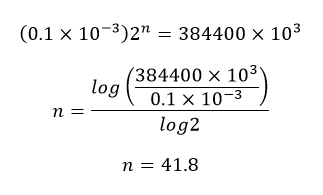To The Moon!
 If you have a piece of paper that is
0
.
1
mm
thick, then how many times will you have to fold it in half in order for it to become tall enough to reach the moon?
If you have a piece of paper that is
0
.
1
mm
thick, then how many times will you have to fold it in half in order for it to become tall enough to reach the moon?
Note: The distance from the earth to the moon is 3 8 4 4 0 0 km .
You have to round off the answer that you are getting to get the answer that you will enter in the answer box.
The answer is 42.
This section requires Javascript.
You are seeing this because something didn't load right. We suggest you, (a) try
refreshing the page, (b) enabling javascript if it is disabled on your browser and,
finally, (c)
loading the
non-javascript version of this page
. We're sorry about the hassle.
7 solutions
Ideally you cannot fold a paper more than 7 to 8 times. Take any paper of any thinness and try that out.
Log in to reply
there is a record for paper folding and the number is 13
Log in to reply
neil its a world record and i think hardik was talking for normal times not for making record
Yeah! You are right! But dont forget that you are given a hypothetical situation!!
right but, it's just a hypothetical question.
Take the length and area pf the paper to be infinite then you can fold it as many times you want
Log in to reply
How would you then reach the end to be able to fold it at all?
No not more than 7
Log in to reply
@Manvesh Dev – yes, more, than 7. even mythbusters managed to do 11, with a paper the size of half of a hangar. still, as everybody mentioned, hypothetical question, so common non-mathematical knowledge, or in this case, misconception, should not be taken in account
Mentioned..both
shouldnt the answer be 43. we have to add the one fold we do to make it 0.2mm
I screwed up ending up to find the sum. Unlucky me
Instead of 0.2 x 2^(n -1), I used 0.1 x 2^n. It amounts to the same thing, but I think my way has the advantage of not needing to find log 0.2.
Log in to reply
Oops. Wasn't thinking. I had to find log 2 to solve this, which is a baby step from finding log 0.2. I still prefer my way, but it really isn't any easier.
It is the answer to the world, the universe, and everything!!!!
Correct, but confusing. Why start with .2 and use n-1? Makes more sense to use .1mm and solve for n.
2^10 is approximately 10^3.
2^40 is a little more than 10^12.
We need 3.84 x 10^12.
So n = 42 satisfies the equation. No calculator necessary.
Log in to reply
Precisely - I too solved along these lines - in my case having worked out that I needed to increase the thickness by a factor of 3.84 x 10 ^ 12 I and noting that each fold would double the thickness. I differed from you in that I took a shorter cut, starting from 2 ^ 20 being just greater than 10 ^ 6, thus 2 ^ 40 = approx 1.2 x 10 ^ 12, and thus we need two further doublings for a total of 42.
Log in to reply
lol 42 the answer to life and everything.
Log in to reply
@Terry Yu – This was one of the reasons behind posting this specific problem. :)
the equation seems to be incorrect, since you are trying to equate a dimension in km with mm. hence using sum in geometric progression formula, the answer comes to 31.84 or 32 folds
Log in to reply
All you have to do to get from km (units of 1,000m) to mm (units of one one-thousandth of a metre) is multiply by one million (one thousand to get from km to m, and then another thousand to get from m to mm), hence, with everything expressed in mm you are looking at the numnber of doublings needed to get from 0.1 to 384,400,000,000, or equivalently, to remove the decimal point, from 1 to 3,840,000,000,000. 20 doublings get you from 1 to 1,048,576, thus 40 doublings get you from 1,048,576 to approximately 1,100,000,000,000 and you need two more doublings to get to (in fact a little past) 3,840,000,000,000 = 42 doublings in total. The key is to turn the kilometres of the distance to the moon into millimetres first, and then start working out the geometrical progression.
What it says! In one folding we have 0.2mm, again folding 0.4mm= 0.1x2^2mm , again folding 0.8mm= 0.1x2^3mm, so on...
Distance upto moon= 384,400 km= 384,400,000,000 mm.
Let on y time folding we have such height,so
=> 0.1x2^y= 384,400,000,000
= y= log 3,844,000,000,000 (base 2)
On solving we have y=41.8057
Means 42 times
please check, 384,400 km= 384,400,000 mm.
Log in to reply
1 kilometre is a thousand metres or a million millimetres, so 384,400km = 384,400 x 1,000 x 1,000 = 384,400,000,000 - you forgot one multiplication by 1,000 in you working out - @Neeraj Agarwal is entirely correct.
the solution to this question, considering purely mathematically, will obviously come out to be 42 as solved by Pranjal Jain.
it is quite interesting to see how fast the power function grows with x. the answer seems quite non-intuitive at first attempt !!
ans= lo g 2 0 . 1 m m 3 8 4 4 0 0 k m = lo g 2 3 8 4 4 0 0 0 0 0 0 0 0 0 = 4 1 . 8 0 5 7 5 . But answer(fold times) is an integer, so answer is 4 2
I've solved that problem in a "brute force" way using php with this handmade script:
$mm = 0.0000001;
$km = 384400;
$i = 0;
while($km>$mm)
{
$km = $km/2;
$i++;
}
echo $i;
the result of that script is 42
Suggestion: I agree with Hardik. When half folding, normally more than 8 times is assumed impossible without tearing it It's kind of like trying to fold a wood board!! We could deal with imaginary unearthly-sized paper, but still it would be folded fatter than theoretical and might even reach moon before 42nd. Maybe the problem could be altered to half cutting and piling. :)

Width after 1 folding a 1 =0.2mm
Now its clearly a Geometric Progression of common ratio 2 as width would double up after each folding.
So a n = 0 . 2 × 2 n − 1 mm
Now using google, distance between earth and moon comes out to be 384400 kms= 3 . 8 4 4 × 1 0 1 1 mm
3 . 8 4 4 × 1 0 1 1 = 0 . 2 × 2 n − 1 Using log and calculator, this n comes out to be 4 1 . 8 0
Hence the answer is 4 2
@Prateek Mehra You should mention the distance between earth and moon. Please also mention question in your another problem called "escalators"